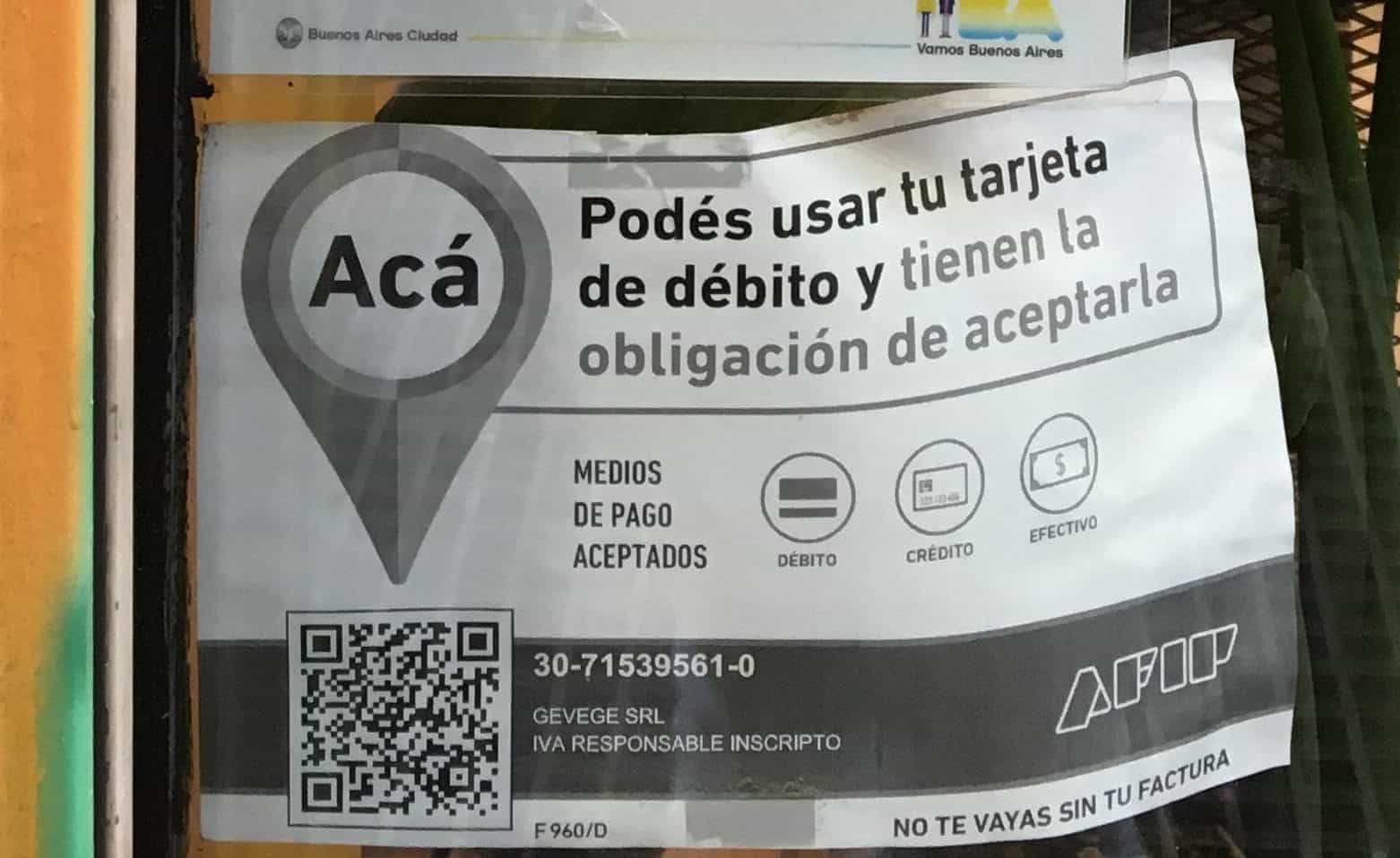1. Cash is king
Most travelers would bring foreign currency to exchange for pesos in Argentina. The most commonly accepted currency is USD, while some places may also take euros and pounds. If you are bringing USD, USD 100 notes would give you a better exchange rate than smaller notes.
Where to change your money for pesos? Changing at the airport would give you an inferior rate so we don’t recommend it. The best would be going to casa de cambio (changing house) in the city. When you arrive at your accommodation, ask your host for recommendations of changing houses near your place.
While it might be possible to use your bank card to cash out at ATM machines, there might be a pricey service charge so we don’t recommend this unless you are really run out of cash.
2. Can I use my credit cards?

A good news is that credit cards are now accepted in many shops and restaurants, even in some kiosks at the corner of the street. You would see some shops posting a notice explaining their obligation to accept credit card payment. There’s no minimum amount for payment with credit card if you see the notice, so this would be a good alternative if you are low in cash, or simply don’t want to go out carrying a large amount of cash.
Most shops would ask you to show documento (identity document) when you are using your credit card to prove your identity. While you can show your passport, they would also accept your ID card from your own country. They would also ask you to write down your document number while you are signing your receipt.
Spanish phrases you would need to know for using your credit card:
¿Puedo pagar con tarjeta?
Can I pay with credit card?
Su documento, por favor. (Usually by the shopkeeper)
Your document, please.
Firme (ud) /Firmá (vos) acá, por favor.
Sign here, please.
Escriba (ud) su/ Escribí (vos) tu número de documento, por favor.
Write (down) your document number, please.
Many shops would offer the option of cuotas (instalments) by credit cards. Unfortunately it’s limited to credit cards issued by Argentine banks.
3. Bargaining and discount
If you are shopping at street markets (e.g. The San Telmo Sunday market), or making an expensive purchase at a shop you may try to bargain for a discount.
When you are buying tango clothes and shoes, there is usually a difference in price between paying in cash and credit card (for example, a pair of tango shoes may cost 2500 pesos by credit card and 2100 pesos by cash).
Make sure to ask for the prices for credit card and cash before deciding on a purchase. Bring enough cash with you if you want the cash discount. If you are really low in cash, many owners would be willing to take a deposit for keeping your purchase, and you can pick it up later when you have enough cash.
Spanish phrases you would need for bargaining:
¿Podés hacerme un descuento, por favor?
Can you give me a discount, please?
(The literal translation of “hacerme” is “make me”)
¿Cúal es la diferencia en precio pagando con tarjeta y efectivo?
What is the difference in price paying by card and cash?
Depósito
Deposit
4. Where can I get cheap groceries?
Throughout the city you can find many chained supermarkets such as Disco, Carrefour and Dia. If you are new in town and speak little/no Spanish, you may feel most comfortable shopping in these supermarkets as you can find everything in one place, and you don’t need to speak much Spanish for the purchase, but it would be the most expensive option.
Another option that would give you a better price would be supermarkets run by Argentine Chinese. You’d easily find them on the street. They are usually well stocked and have more or less the same variety of goods of major supermarkets, and the price would be clearly displayed.
The Chinese shopkeepers usually speak some Spanish (and Mandarin, of course), but you don’t usually need to speak much to finish the purchase.
If you speak some Spanish you may venture into grocery stores on the street, where you would usually find fresher products at better prices than chained supermarkets, but you would need to know how to ask for the goods and the price.
Spanish phrases you would need for shopping:
“¿Cuánto cuesta/sale …?”
How much…
Darme (the product), por favor.
Give me…, please.
¿Algo más? (Usually from the shopkeeper)
Anything else?
Nada más.
Nothing more.
5. Where is the line?
Sometimes when you enter a shop you would see many locals waiting for service, but there is no line. In Argentina many shops would have a ticket dispenser by the door from which you can get a ticket with a number. The shopkeeper would call out the number of people who are waiting to be served.
Finally, it’s best for you to do all your shopping from Monday to Saturday, as most shops would close on Sunday in Buenos Aires! You may also want to avoid peak hours when the shops are crowded, which are evenings in weekdays, when people are off from work; and midday and nights on Saturday when people shop for family gatherings and asados (barbecues) etc.
Traveling to Buenos Aires soon? Book a class with our Argentine Spanish teachers who are tangueras to help you to learn more Spanish and get more insider tips for the Buenos Aires tango scene!
Also get a copy of our books “Tango Spanish and Buenos Aires Travel tips” and “Tango Spanish: Essential Phrase book for Tango Class and language guide for tango shoe shopping”!

